Networks
Networks are used to join up several computers (PC's) together and link them so that you can share files, programs, applications etc, etc. To build a network you have network cables to join up to link together for personal or business PC's to grow and expand for multiple uses.We need 4 twisted pairs of cables to join up to each computer. Below will give the basic requirements needed to build a network.
All devices that are attached to a computer network uses an IP address. Each computer / device will have it's own IP address. IP addresses are composed of numbers separated by dots, such as 192.168.1.1, and serve two main functions: identifying the host's network interface and providing its location in the network.
These are resolved into hostnames and go through a domain name system server, to allow communication with each other over the internet and on other computer networks. It uses a variety of protocols and algorithms which are also used to specify the transmission of data to other devices.
Network systems must follow certain standards or guidelines in order to operate.
For example, the Ethernet standard establishes a common communication language for wired or physical networks, and the 802.11 standard specifies connectivity for wireless local area networks (WLANs).
A computer network is designed in such a way that makes it possible for large network structures to communicate with each other.
What does RJ45 Stand for?
The RJ in RJ45 stands for Registered Jack. The RJ45 connector is a commonly used modular interconnection device, matched with a cable to provide data communication service to various electronic devices and network systems.What is a RJ45 Plug
The RJ45 plug connector, contains metal contacts separated by insulating plastic channels. The channels fit into a matching socket and the connectors lock in place with a tab making them secure but also can be removable. Internal wired, using RJ45 devices contain 8 pins and 8 wire positions can be used to handle signals or power, so they can accommodate 4 twisted wire pairs. RJ45 devices are mostly used to connect an internet-enabled device (such as a Computer or PC) with another network devices such as a Router, Modems, Servers, Smart TV or Gaming Console's, plus other devices that use the Ethernet protocol. Ethernet networks are very common in both professional and domestic environments. Hardwiring usually, using RJ45 devices, depending of the wiring types can enables higher data speeds with stability and security of data transfer, which makes the use attractive in the work industry.What is the difference between Cat5 verses Cat6 Cabling
Todays cabling used in Ethernet and EtherCAT networks are available in different versions. Cat5 which is older cable while Cat6 cables are more common today. These cables are both used to connect computers in a network, but their performance greatly differs between them.Cat5 cables is made of 4 twisted pairs of wire and, while still widely used, it has become obsolete, due to better cables.
Cat5e is also made of 4 twisted pairs of wire but when Cat5e was introduced, it was up to 10X faster than Cat5, and offered greater resistance to crosstalk, or interference.
Cat6 is also made from 4 twisted pairs, but it is even faster than Cat5e, It also has greater bandwidth capacity and functionality, it reduces crosstalk or interference via it's shielding, and it is backwards compatible with Cat5 and Cat5e. Cat6 cable is typically used in all network installations today that can now reach Gigabit speeds.
The newer Cat6a cable has thicker plastic casing and further reduces crosstalk, which now can be used for longer cable runs of up to 100 meters, without problem.
Cat6 cables has speeds of 1Ghz and a maximum bandwidth of 250Mhz. Cat 6a, Cat7 and Cat7a cables can run at speeds up to 10,000Mbps which vastly improves the bandwidth that it can run at. The maximum bandwidth frequency for Cat6a is 500Mhz, while Cat7 is 600Mhz, and Cat7a bandwidth is higher still and runs at 1Ghz.
Remember that all of these cable designs operates with 4 twisted pairs, or eight wires, hence the necessity of RJ45 connectors with 8 pins to connect all those wires. All the Cat series cables all use the same RJ45 connectors.
RJ45 Connector Pinout Types
There are two RJ45 pinout standards, called T568A and T568B. The pinout connections are different between these two standards. The color-coded wires must be inserted into the correct pinout locations in the RJ45 connector to function correctly for an Ethernet network.See the photos below.
These standards define which colours of the eight wires go into the connector. Each standard has its own layout of the colour schemes which you must follow. Do not mix the standards up when you are making up patch leads. The T568A standard offers backward compatibility with older wiring.
The T568B standard offers much better signal isolation and noise protection. You can use either A or B will work in an Ethernet network.
T568B is the mostly used standard with todays networks.
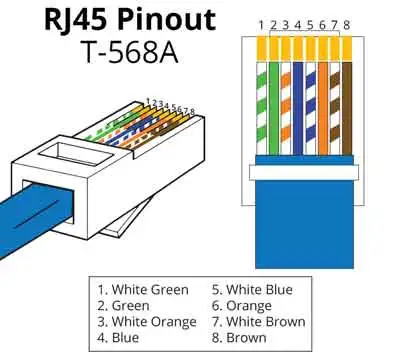 Photo 1.
Photo 1.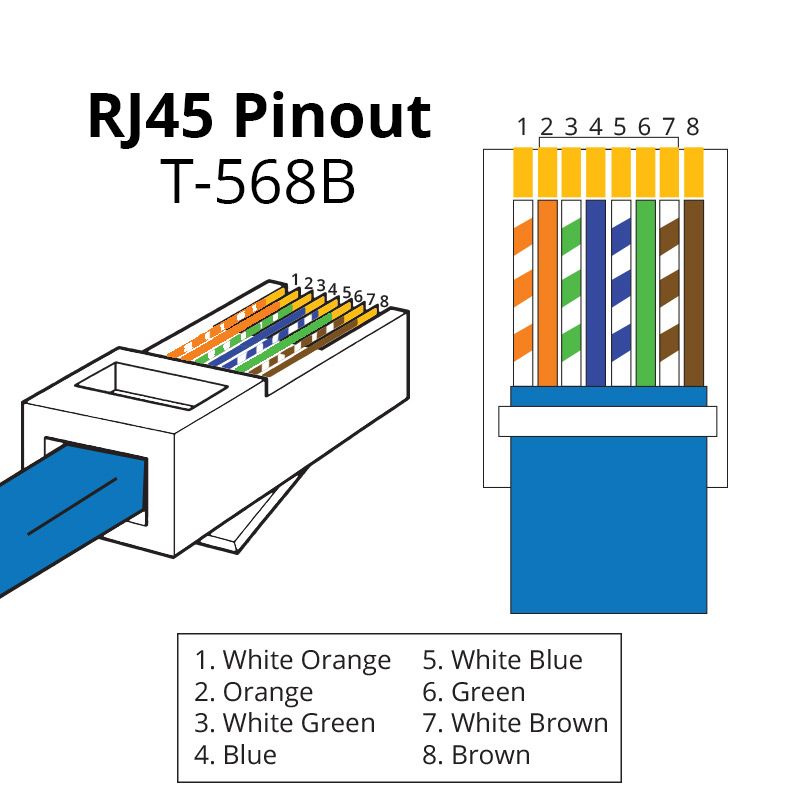 Photo 2.
Photo 2.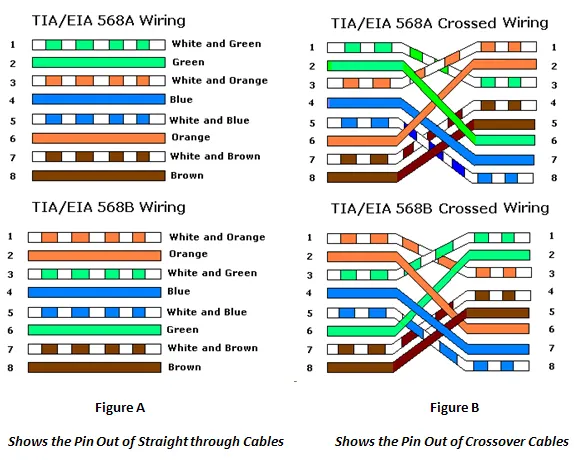
Photo 3. RJ45 Connector Pinout Types with Crossover.
Crossover cables are used when connecting direct to another computer, without the use of a switch.Switch or Hub
A switch can come in many types and forms from a 4 way, 8, 16 or higher ports. It can also be refered to as a hub. The use of a switch hub is an essential networking device that allows multiple devices to connect to a network, facilitating communication and data transfer.What is a Server
A server is a specialized computer system designed to provide services, that may include data, or resources to other computers, also known as clients, over a network. These services can range from delivering web pages and email to storing and managing files or running applications. Servers are the digital workhorses that power much of our modern world like google, that stores everything you need to know. It’s essential power is mind blowing to grasp the wide array of tasks that they can perform.RJ45 Sockets
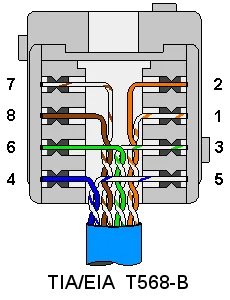
Photo 4. RJ45 Network Socket.
Most RJ45 sockets will have the colour codes marked on them for both standards, so when wiring up these, to make sure you follow and use the correct wiring code standards at both ends.Photo 4. above shows the wiring for T568B standard.
Cable Testers and Tools
To fit the cables to the sockets and plugs you need a punch down tool. and a special crimping tool.Depending on the quality these can be expensive to buy. To test the cables you can use a RJ45 / RJ11 tester. These are quite cheap and are a must for checking patch cables and for fault finding.
Typical Network Layout
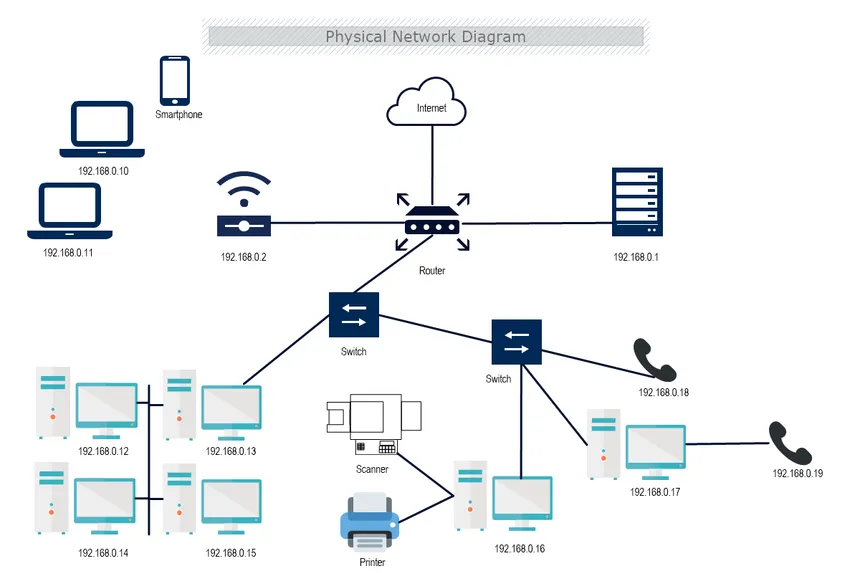
Photo 5. Typical Network layout.
A typicial layout in photo 5. shows a wireless network, (top left) and 4 computers (bottom left). These could be anywhere in the house or office which are connected through a switch to the router which is also connected to a server. (top right)
Each computer would have a RJ45 cable, using cat6a going to the switch. The switch (on the left) shows it goes to another switch (to the right). This is still connected to the same network but this group could be in another part of the building. As long as you connect the PC to the switch or router you will still be on the same network. You can keep adding on to the network to suit your needs, as long as you have enough ports on the switch. You could also remove both switches and install a bigger hub switch to expand your network. Generally the bigger the hub switch the more it may cost so by having two switches may have been done to save on cost.
As this also is connected to another 2 computers (bottom right) it also shows it has a printer and scanner connected.
With printers you can also have network printers (stand alone) which would connect directly to the switch. This would allow all PC's to have access through the network to the printer.
The current network layout above would mean all PC's can or may have access to the printer, but the computer that the printer is connected to would have to remain switched on for other PC's to access it, plus it would also need to have print sharing turned on, so that it can be allowed access shared across the network. This layout could also be the only computer that needs access to a printer, and the rest may not need to print.
A server is used, so that each PC can have access to files being shared.
There are two VOIP (Voice Over Internet Protocol) phones on the network. These may need a program to run these phones.
Not all PC's may have access directly to each other over on the network, but it can be set up so they would all see the server and would update, run or transfer files to share through the network.
I hope that this helps you on understanding how a basic network operates.
Have fun.
